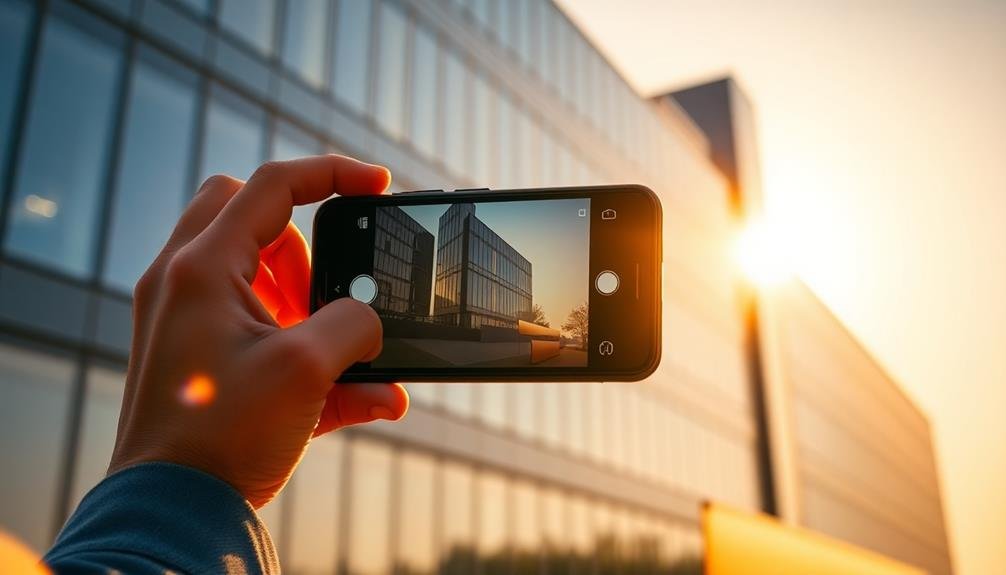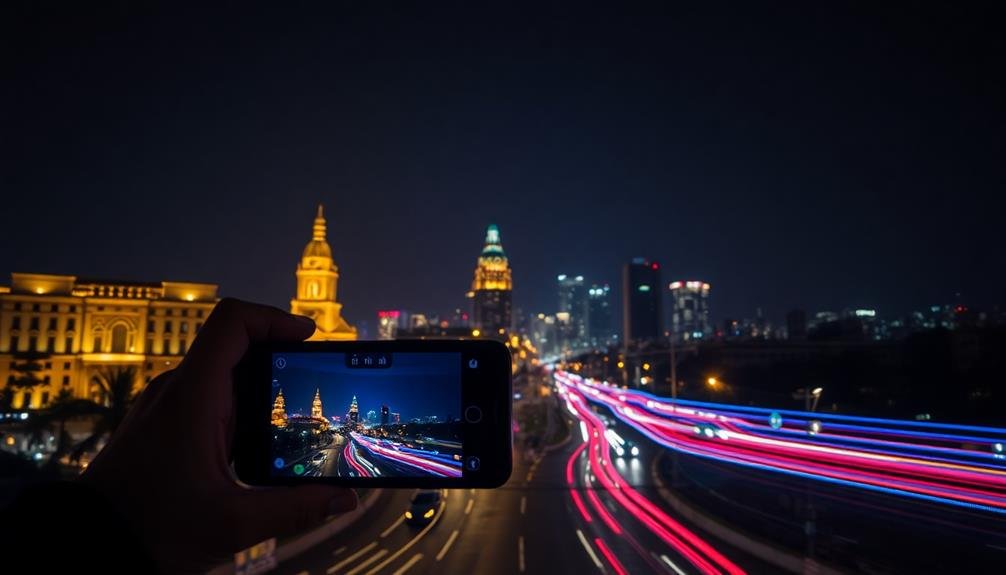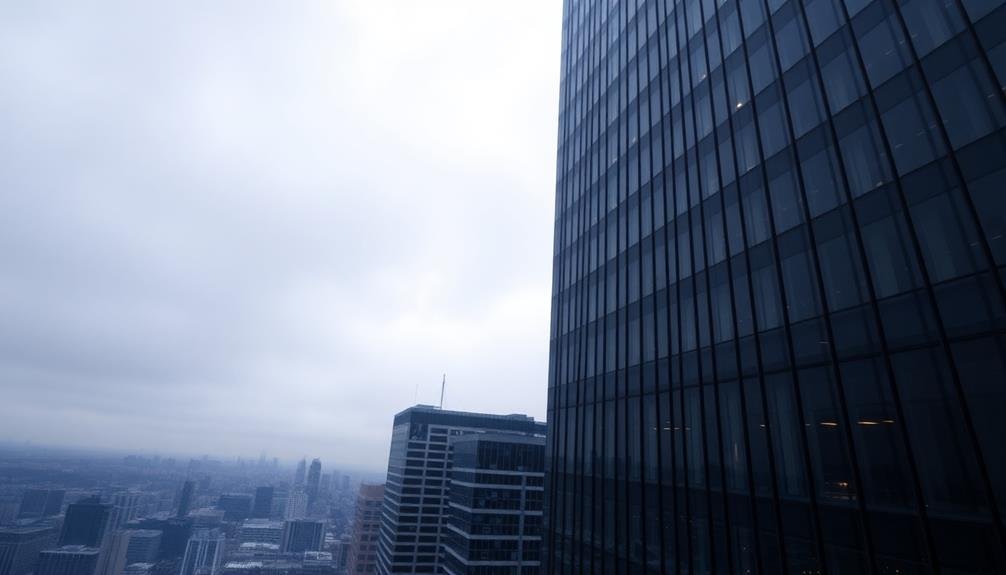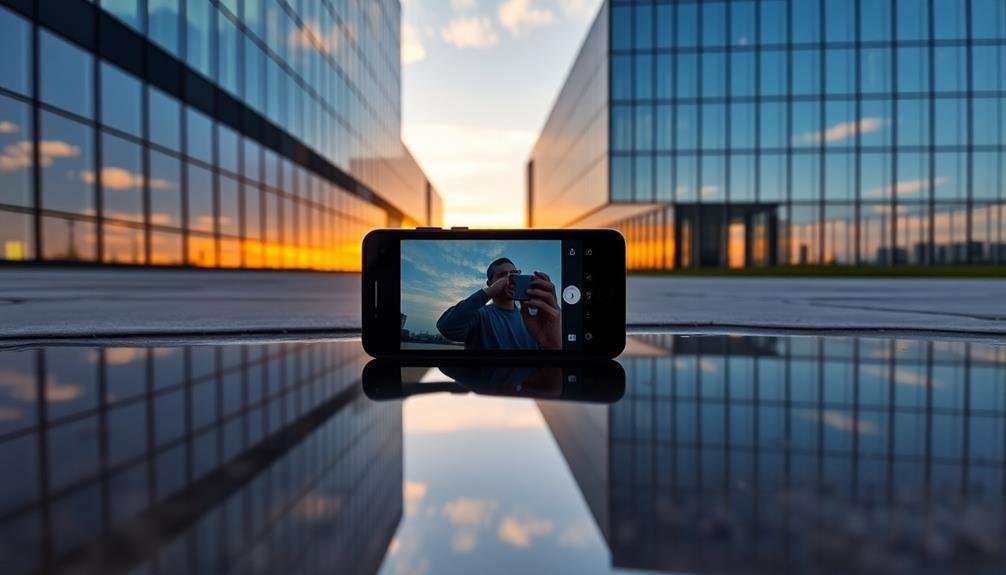Elevate your mobile architecture photography with these five lighting tricks. Capture the warm, golden hues of sunrise and sunset for a magical glow. Use dramatic shadows and highlights to add depth and contrast to your shots. Try night photography light painting to create stunning, illuminated facades. Take advantage of cloudy days for soft, even lighting that reveals textures. Finally, incorporate reflections for unique perspectives and added visual interest. Each technique offers a different way to showcase architectural beauty, from ethereal atmospheres to striking contrasts. Mastering these lighting tricks will transform your mobile architecture photos into enchanting works of art.
Golden Hour Glow

Capturing the golden hour glow can transform ordinary architectural shots into breathtaking masterpieces. This magical time occurs shortly after sunrise and before sunset when the sun is low on the horizon, casting a warm, soft light that bathes buildings in a golden hue.
To make the most of this fleeting moment, plan your shoot in advance. Research the exact timing of golden hour for your location and arrive early to set up.
Position yourself to capture the sun's rays as they hit the building's facade. Look for interesting angles that showcase the interplay between light and shadow. Use your phone's HDR mode to balance the bright sky with darker architectural details.
Experiment with silhouettes by placing the building between you and the sun. Don't forget to adjust your white balance to "cloudy" or "shade" to enhance the warm tones.
If you're shooting glass buildings, watch for stunning reflections as the golden light bounces off their surfaces. Move around to find the perfect composition that highlights the architecture's unique features.
Dramatic Shadows and Highlights

How can you harness the power of shadows and highlights to create striking architectural images? By strategically using light and shade, you'll transform ordinary structures into fascinating subjects.
Look for stark contrasts between sunlit areas and deep shadows to add depth and drama to your photos. Aim to capture these effects during early morning or late afternoon when the sun's angle creates long, dramatic shadows.
To make the most of dramatic shadows and highlights:
- Position yourself so that strong sunlight falls across the building's facade at an angle, creating a pattern of light and dark.
- Frame your shot to include both brightly lit areas and deep shadows, emphasizing the building's textures and architectural details.
- Experiment with silhouettes by placing the sun behind the structure, creating a striking outline against a bright sky.
- Use HDR mode to capture a wider range of tones, preserving details in both highlights and shadows.
Don't be afraid to underexpose slightly to enhance shadow details. You can always adjust brightness in post-processing.
Night Photography Light Painting

Illuminating architectural marvels after dark, night photography light painting offers a unique way to showcase buildings in a magical glow. You'll need a tripod, a long exposure setting, and a light source like a flashlight or LED panel. Start by setting up your shot and framing the building. Use a low ISO and small aperture for crisp details, then experiment with shutter speeds between 10-30 seconds.
As your camera captures the scene, move your light source to "paint" the building's features. Sweep the light across facades, highlight architectural details, or create light trails. You can even use colored gels for dramatic effects. Remember, consistency in your movements is key for smooth, even lighting.
| Technique | Effect | Best For | Light Source | Duration |
|---|---|---|---|---|
| Outlining | Defines building edges | Modern structures | Flashlight | 10-15s |
| Soft Wash | Even illumination | Classical architecture | LED panel | 20-30s |
| Accent Lighting | Highlights specific areas | Textured surfaces | Narrow beam | 15-20s |
| Color Splash | Adds vibrancy | Monotone buildings | Colored LEDs | 10-15s |
| Light Trails | Creates dynamic lines | Symmetrical compositions | Moving light | 20-30s |
Experiment with these techniques to create stunning, otherworldly images that transform familiar architecture into enchanting nighttime scenes.
Cloudy Day Soft Illumination

While most photographers dread overcast weather, cloudy days can be a blessing for architectural photography. The soft, diffused light eliminates harsh shadows and reduces contrast, allowing you to capture the building's details with greater clarity.
Overcast conditions create an even illumination that highlights textures and brings out the subtle nuances of the structure's design.
To make the most of cloudy day soft illumination:
- Position yourself to capture the building's best angles, emphasizing its unique features.
- Use a polarizing filter to reduce glare and enhance color saturation.
- Experiment with longer exposures to create a dreamy atmosphere with moving clouds.
- Focus on architectural details that might be lost in harsh sunlight.
Don't be afraid to adjust your camera's white balance to counteract the cooler tones typical of overcast days.
You'll often find that the soft light brings out rich, saturated colors in the building's materials. Take advantage of the uniform lighting to shoot both wide-angle views and close-up details.
Reflections for Unique Perspectives

Reflections can transform ordinary architectural shots into fascinating images with depth and intrigue. When you're out capturing architecture with your mobile device, keep an eye out for reflective surfaces that can add a unique perspective to your photos. Look for puddles after rain, polished marble floors, or glass windows on nearby buildings.
To capture stunning reflections, position yourself at an angle where you can see both the building and its reflection. Experiment with different angles and heights to find the most compelling composition. You'll often find that shooting from a lower angle can emphasize the reflection and create a more dramatic effect.
Don't be afraid to include partial reflections in your shots. Sometimes, a fragmented or distorted reflection can add an abstract element to your image. Use the reflection to frame your subject or create symmetry in your composition. You can also play with the balance between the real structure and its reflection, adjusting your framing to emphasize one over the other.
Remember to keep your lens clean and steady to capture crisp reflections. If possible, use a mobile tripod or rest your device on a stable surface to minimize camera shake.
Frequently Asked Questions
How Do I Manage Glare When Photographing Buildings With Reflective Surfaces?
To manage glare on reflective buildings, you'll want to use a polarizing filter, adjust your angle, and shoot during softer light conditions. You can also try HDR techniques or bracket your exposures to capture details in high-contrast areas.
What's the Best Way to Capture Architectural Details in Low-Light Conditions?
To capture architectural details in low light, you'll want to use a tripod, slow shutter speed, and wide aperture. Experiment with long exposures and adjust your ISO carefully. Don't forget to bring a remote shutter release for sharp images.
Are There Any Specific Camera Settings for Photographing Tall Buildings?
To photograph tall buildings, you'll want to use a wide-angle lens and a small aperture (f/8-f/11) for depth of field. Tilt your camera upwards and enable lens correction to minimize distortion. Consider using HDR for balanced exposures.
How Can I Minimize Lens Distortion When Shooting Wide-Angle Architectural Photos?
To minimize lens distortion in wide-angle architectural shots, you'll want to keep your camera level and centered. Use a tripod, avoid tilting the camera, and position yourself at the building's midpoint. Post-processing software can also help correct distortion.
What Are Some Techniques for Balancing Artificial and Natural Light in Interior Shots?
You'll want to balance artificial and natural light carefully. Use reflectors to bounce sunlight, adjust curtains for control, and employ fill flash or portable LED panels to complement ambient light. Experiment with white balance for cohesive results.
In Summary
You've now got five powerful lighting tricks in your mobile photography arsenal. Don't be afraid to experiment with these techniques to capture stunning architectural shots. Remember, lighting can transform an ordinary building into a work of art. Whether you're chasing the golden hour glow or painting with light at night, keep practicing and refining your skills. With these tricks, you'll soon be creating breathtaking architectural photos that'll stop viewers in their tracks.





Leave a Reply